The interior design SEO blueprint: keywords that attract clients, structure that ranks, and content that sells your aesthetic, backed by 70+ real site results.
5.0

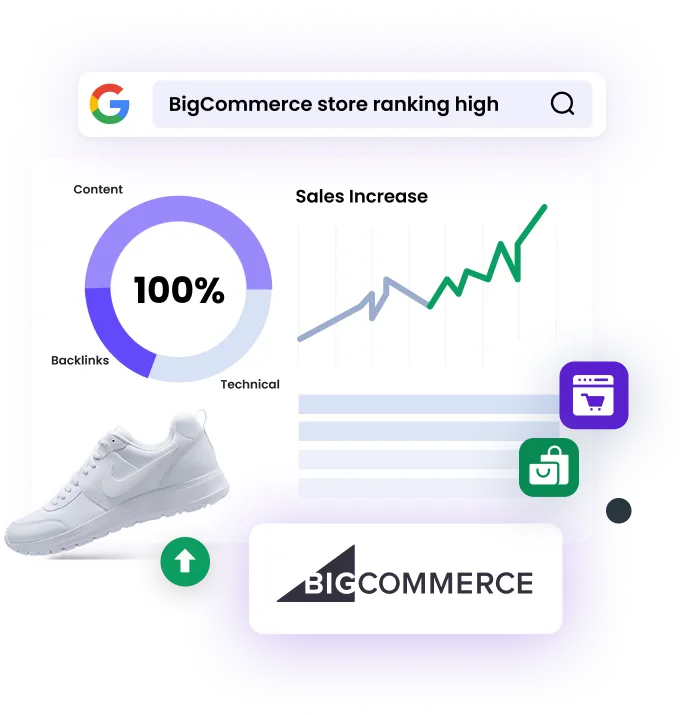
The interior design industry is growing 3.9% each year, with more than 150,000 designers competing across the U.S. Standing out takes more than beautiful work — it takes being found.
Most designers spend months perfecting projects, leaving little time for marketing. Ads fade fast, and even the most elegant websites often stay unseen. That’s why visibility matters as much as design. Interior design SEO helps your work reach the right audience, consistently and organically.
What follows comes from our experience as an SEO company for interior design that’s partnered with 70+ studios: fundamental strategies we’ve tested, refined, and proven to grow traffic, trust, and client inquiries.
Now, we’ll review each step to ensure you have the right tools and strategies for your interior design SEO.
Before anything else, know what your clients are searching for, and match your content to it.
Most people search for specifics like “modern apartment design in miami” or “scandinavian living room ideas.”
Start simple:
Focus on long-tail keywords, such as specific phrases with higher intent, like “luxury condo interior design los angeles.” They’re easier to rank for and attract the right audience.
The interior design niche is competitive, so steady keyword work pays off more than quick wins.
Example high-intent keywords:
Here are more examples of high-intent local keywords:

Here are other keywords with higher difficulty that you can to add to your strategy:

There are thousands of keywords like these waiting to be used. But turning them into a clear plan—what pages to build, what to write, and how to rank locally—takes strategy.
We’ll connect each topic to your services, styles, and neighborhoods so the right clients find you. Want a free audit to see how it could look? Send us your website.
Keyword research gives you the “what.” Now it’s time to shape the “where.”
A clear website structure helps both Google and your visitors understand your services. With a good hierarchy, Google knows how your pages connect, and clients can quickly find what they need: “home interiors,” “office design,” or “renovation projects.”
Think of your site like a design layout: every element should have a purpose and flow.
Your interior design website should include:
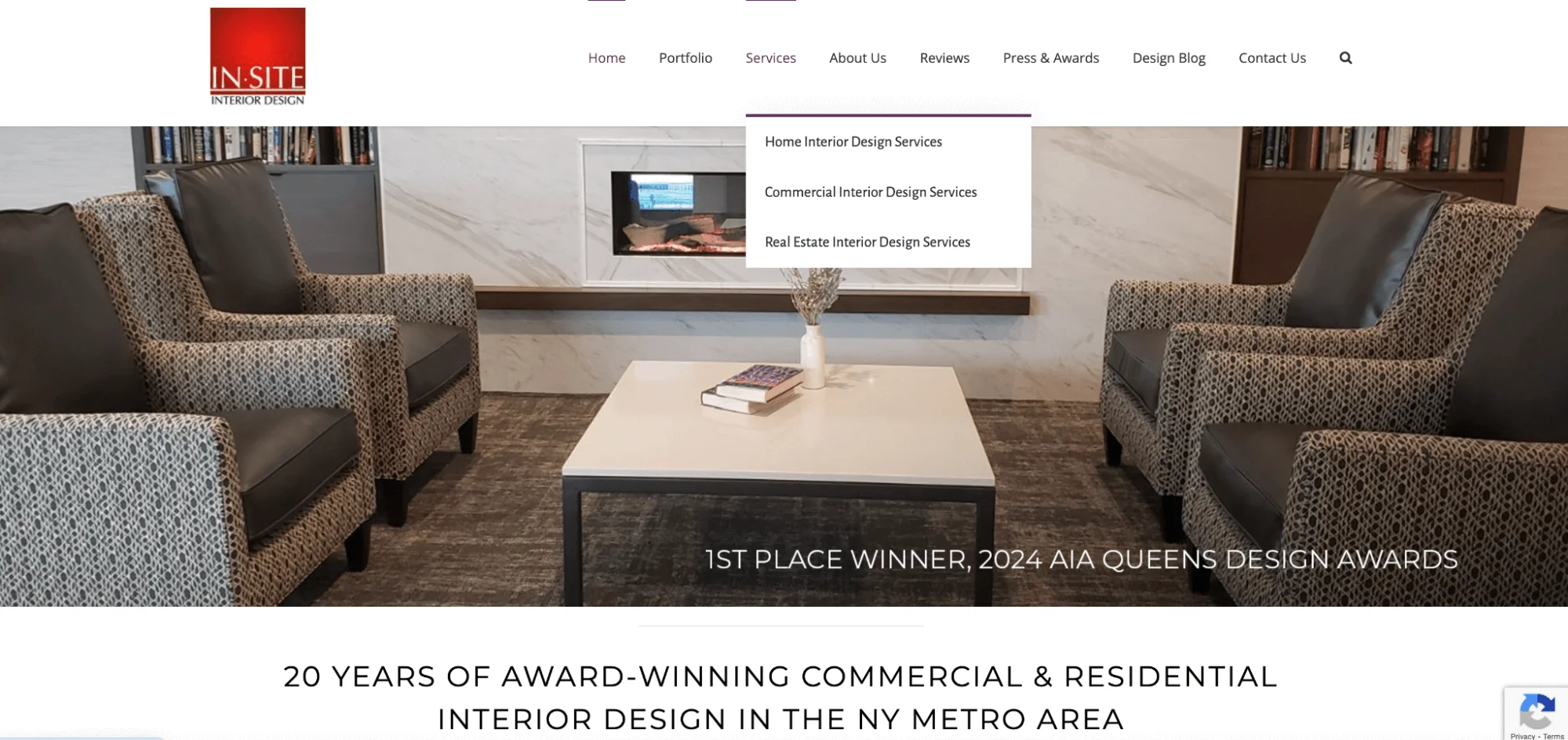
From there, add your key services directly to the main navigation menu so visitors (and Google) see them right away.
If you offer a special feature (design visualizer, virtual consultation, or online design tool), include it in your navigation. It’s both a strong user cue and a signal of your originality.
For example, one designer highlights their “Design Assist” tool right in the top menu: smart, simple, and instantly clickable (see below).

Your service pages are where keyword strategy turns into real traffic. Each one should speak to a specific design need or project type, like kitchens, offices, or full renovations.
For example, create separate pages for:
These should also go to our navigation menu to enhance your interior design SEO.
The screenshots below show smart examples of menus linking directly to specific service pages.


Designing for both homes and businesses? Show that range clearly.
Group your work into two main sections — residential and commercial — and show what fits under each. For example:
Each category deserves its own page with the proper keyword focus, like “residential interior design services” or “commercial interior design firm.” From there, link to your subpages so both visitors and Google can easily follow your structure.
This approach strengthens your interior design SEO by clearly signaling your areas of expertise.
Below is an example of a well-organized navigation that separates residential and commercial projects.

Residential design is almost always local; homeowners want someone nearby. Commercial projects, however, can span multiple cities or even countries.
That difference matters for interior design SEO. Use location-specific pages for residential services (like “interior designer in austin”), and broader regional or national pages for commercial work, depending on your reach.
You can feature your service areas in the footer or navigation bar, linking each one to its own location page.
Below is an example of a navigation setup that clearly highlights service areas.

Think of your blog as your website’s mood board: full of color, ideas, and inspiration that draw clients in before they ever reach out.
People search for phrases like “cozy bedroom ideas” or “modern kitchen design,” and that’s how they’ll find you. Your goal is to be genuinely helpful. When readers find useful content, they see you as an expert and return when they’re ready for a whole project. Google rewards that kind of value as well.
Plan your blog with content clusters: grouping posts around core services. If you offer kitchen design, write about “layout planning” or “color trends for kitchens.”
We’ll show how to organize these clusters in an example later in this guide.
Stop Guessing Your Interior Design Website Structure—We Will Show You Exactly What Pages You Need
Your website should do more than showcase your work; it should bring you clients. After partnering with 70+ interior design firms, we know which pages drive inquiries and how to structure them for lasting visibility. Let’s help you build a site that works as hard as you do.
Earlier, we mentioned how residential design is typically local, while commercial projects often reach a wider area. That’s exactly what local SEO helps you target the right locations for your specific audience.
The strategy you use should match your business reach. Most interior design companies fall into three groups:
Each level requires a different interior design SEO setup. Let’s break it down.
When your studio focuses on one city or region, think local first. Center your content around your main service area.
Use natural phrases clients search, like “modern interior designer in los angeles” or “home renovation design in santa monica.” Then weave those terms into key elements such as your page titles, meta descriptions, and headings.
You don’t need to repeat the same keyword endlessly; quality writing that clearly signals location works better for both Google and your readers.
Here’s an example of a design studio that keeps its messaging local while maintaining a polished, professional feel.

If your firm works across several states, your SEO should reflect that wider reach: highlight all the regions or states you serve throughout your site. Include those areas in your copy, footer, and navigation so Google can easily find their location.
Additionally, your URL structure should clearly reflect this. For example:

This signals to Google that you’re an interior design firm with multi-city expertise, not a generic directory.

If you design across borders, your interior SEO should show that international scope and authority.
Don’t list every location. Spotlight your flagship cities, the ones where your projects or clients are most recognized. Create pages that feature country-specific portfolios, local press, or collaborations to strengthen your relevance in each market.
Use structured, geo-specific URLs like:

Most local clients find interior designers through Google Maps long before they visit a website. A strong Google Business Profile (GBP) makes sure your studio shows up and stands out when they search “interior designer near me.”
Here’s how to make yours work:
Here is an example of a well-optimized GBP of an interior design company in LA:
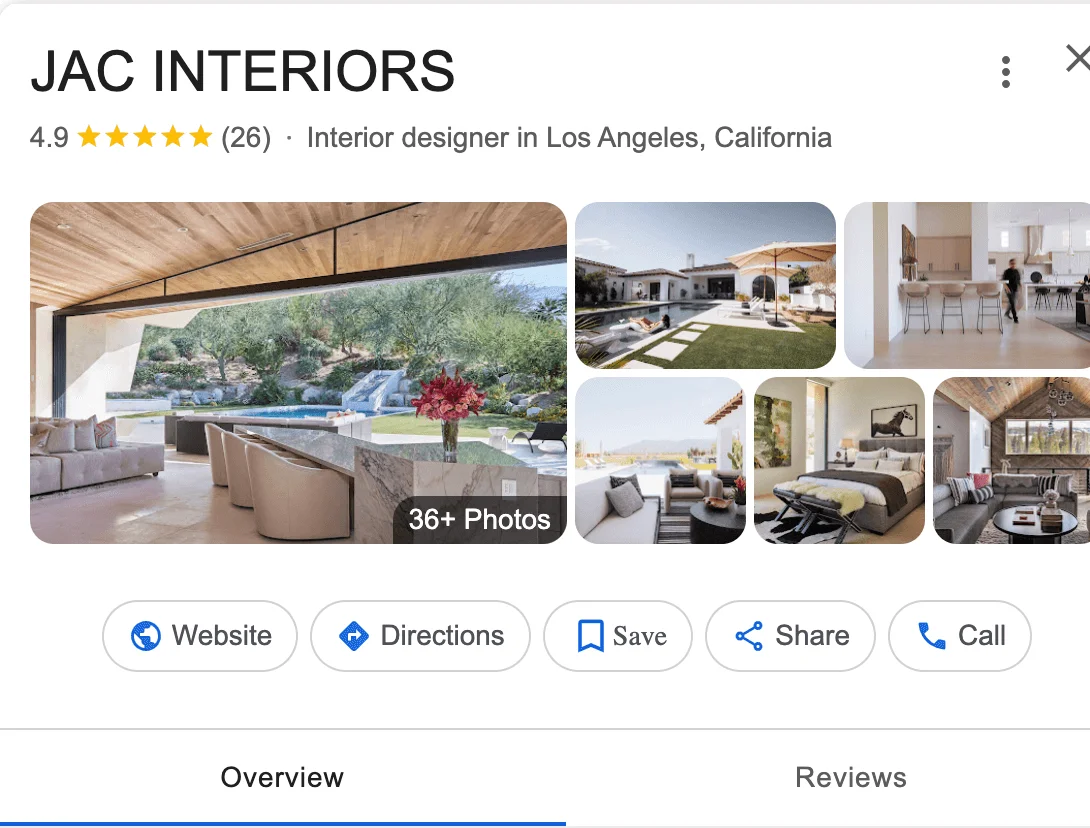

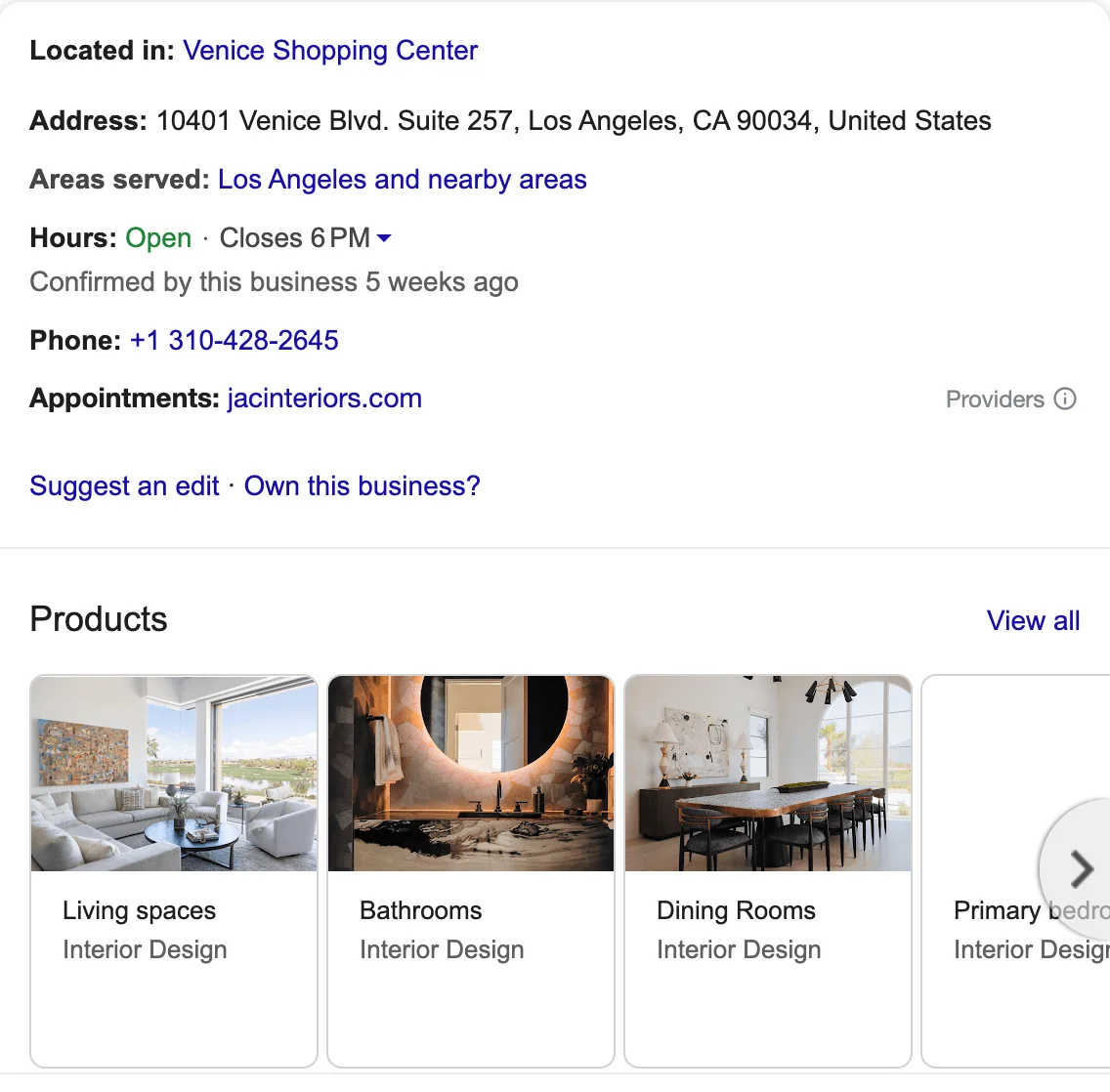


This is how you will show up in Google Maps after optimizing your GBP:

Even after your keyword research and local pages are done, your interior design SEO work isn’t over. Visitors stay and convert only when they see content that feels valuable, inspiring, and credible.
For interior designers, that means creating fresh, thoughtful content that reflects your aesthetic and expertise while helping clients find what they need. Include:


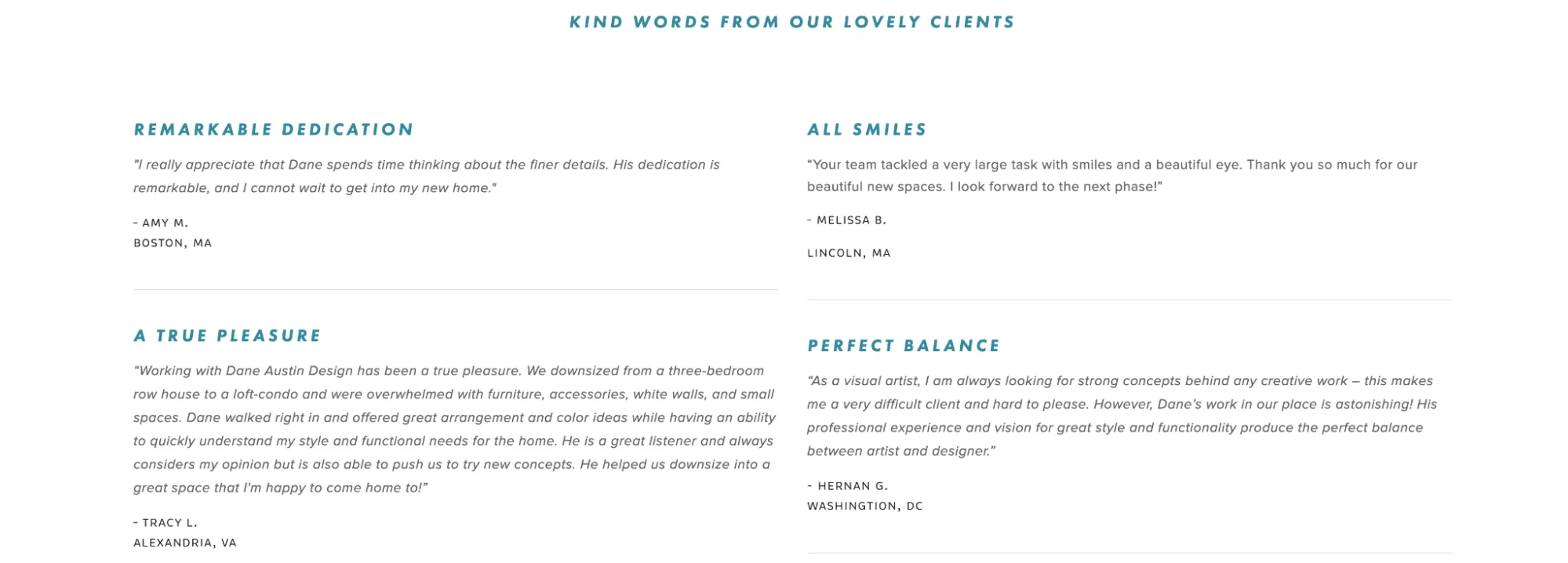


Blog content works best when it connects directly to what you offer. Instead of random design topics, organize posts around each leading service; this helps Google understand your expertise and builds a natural path from inspiration to inquiry. That’s the content clustering we referred to.
For example, if you offer “bedroom interior design,” write articles like:
Each post should link back to your “bedroom interior design” service page. That connection reinforces authority and helps potential clients move from browsing to booking.
To find post ideas, check Google’s People Also Ask and Related Searches for questions real clients are typing in.

Once you’ve picked your blog topics, focus on clarity and structure. Each post should be easy to read, visually engaging, and built to rank:
Example of a well-optimized meta title and description for a blog post.

The next step is technical SEO for interior design companies: the behind-the-scenes work that helps Google crawl your site and rank you.
Three essentials here are:
Here’s an example of what an XML sitemap looks like.

Schema markup tells Google what your content means, not just what it says. For interior design websites, it can highlight key details like your services, reviews, team, and portfolio images.
When used correctly, schema helps your pages appear with rich results such as ratings, FAQs, or featured images.

Recommended schema types for interior design websites:
Even a few schema tags can help search engines better represent your design business and make your listings look more polished on Google.
Your URL layout affects both SEO and user trust. No one (including Google) trusts URLs that contain numbers, random symbols, and lengthy, complex text.
So, go for short, readable URLs that help Google understand your pages, and make them easier for clients to remember and share.
SEO-Friendly URLs:
Non-SEO-Friendly URLs:
Internal links connect your pages, making them easy to navigate. Done right, they guide readers through your services, show more of your work, and strengthen your site’s SEO structure.
Here’s how to do it effectively:
Internal linking keeps users exploring your site and helps Google understand which pages matter most, essential for interior design SEO.

A stunning interior design website only works if it performs beautifully on mobile. Most people browse design ideas on their phones; slow or clunky pages send them elsewhere.
Focus on:
Smooth mobile performance supports every part of your interior design SEO strategy.
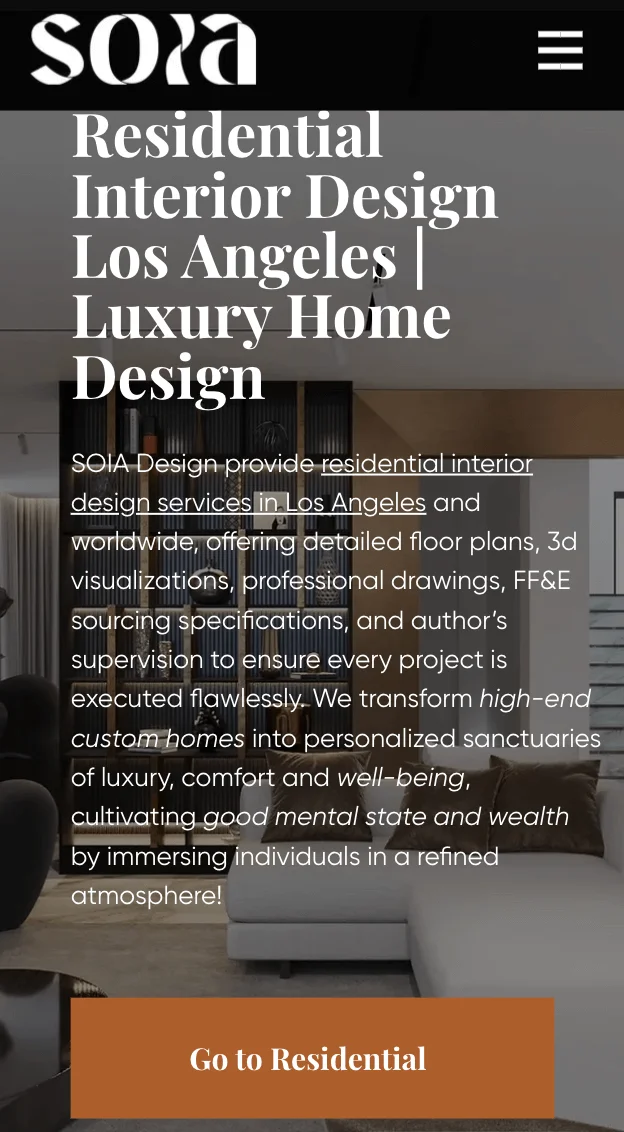
Loading is essential not only on mobile; so, let’s make yours fast to keep visitors engaged and help your pages rank higher in Google.
To improve speed:
Tools like Google PageSpeed Insights and GTmetrix show where to improve; so, use them to test regularly.

Key Core Web Vitals to monitor:

Passing these metrics means faster load times, better rankings, and a smoother experience for design clients browsing your portfolio.
Your interior design website will evolve constantly: new projects, photos, and layouts keep your portfolio fresh, but can quietly slow things down. Each update can impact site speed or SEO performance, so it’s advisable to check your technical setup regularly.
Tools to use for checks: Google Search Console and Screaming Frog.
If you’re not sure where to start, we can review your setup with our 150+ item technical audit checklist and highlight easy wins to make your site faster, smoother, and fully optimized for search.
Lastly, you need strong backlinks. They’ll help Google see your site as trustworthy and credible.
Focus on earning links from sites that make sense for your niche: design blogs, architecture magazines, renovation platforms, furniture brands, and local business directories.
Let’s check out our four proven link-building strategies.
First, two effective ways to earn backlinks for interior design SEO:
Some website examples you can use for guest blogging or link insertion:
Listing your studio in reputable directories helps build trust and authority, both for Google and potential clients. To make your listings stand out:
Interior design directories to consider:
Also, list your business on broader local directories like:
This is how interior design companies show up in directories:

The final strategy is digital PR, a fast, credible way to build authority and boost your rankings. Here’s how it works:
You come up with an interesting story, insight, or press release about your work—something that’s genuinely newsworthy in the world of design. Then you pitch that idea to hundreds of journalists and editors across different platforms.
If one of them finds your story valuable, they might feature it on a high-authority outlet—like interiordesign.net or elledecor.com. That kind of coverage doesn’t just drive traffic; it also earns powerful backlinks and builds your reputation in the industry.
Once your interior design SEO is in motion, tracking progress helps you see what’s resonating and where to refine.
The more you measure, the better you’ll understand how potential clients find and interact with your brand, and what keeps them coming back.
Use there tools for tracking your interior design SEO success:
You’ve read this far, and you probably know exactly what your design website needs. You just need the time, strategy, or guidance to make it happen. That’s where we can help.
We’ve helped 70+ interior design studios refine their SEO, attract dream clients, and turn beautiful portfolios into steady project inquiries. Let’s create the same results for you, with a clear, data-backed strategy tailored to your style and goals.
Submit the form - Get Free Proposal
%202.png)
24 hours